 Your new post is loading...
 Your new post is loading...
...Up to 15 seconds of video, 13 custom filters, and a "cinema mode" for stabilization. Those were some of the features added to Instagram last week, instantly turning the popular photo-sharing app used by 130 million people into a video-sharing service. Within the first 24 hours of the announcement, over 5 million videos had been uploaded.Sure, some were of frothy lattes and the Miami Heat winning the NBA finals, but the new features have wider appeal than to just casual users.
As newsrooms are now relying on social media as a platform to discover and deliver the news, Instagram's new video features will add another piece of content into the mix for organizations: short, solid-looking video clips.Beth Bennett, assistant professor at The Medill School of Journalism, Media, Integrated Marketing Communications at Northwestern University, believes this will be the next big thing for news organizations....
At this point, there’s no shortage of mobile products created by newspapers. Staffs are developing general news apps, sure, but in many cases they’re also tacking on a host of more niche apps. They’re also being more thoughtful about the types of journalistic content suited for mobile consumption and the extent to which clean presentations make this content sing. The apps that resonate with me most play up the functionality of the device, are useful to readers, and give information to help citizens lead better lives on the go. Newspapers, I believe, are learning that what works on a smartphone is different than what works on a tablet. What’s a helpful app in Los Angeles is different than what passes for a helpful app in Cleveland. And a newspaper staff that understands their community is better positioned than most to make these sorts of product adjustments to suit the market. Having said that, here are my picks for best newspaper apps. I listed my selections by newspaper and then explained the particular app or apps by that publication that stand out. Some have excelled in apps that are geared toward more lifestyle topics while others have done well with more traditional news coverage. All the apps are free of charge (or free for a limited time), which goes against the business model of most papers who are starting to charge for apps of their news content....
...Are you planning projects that member outlets would be able to incorporate into their own websites? Absolutely! All of our interactives are embeddable, and our members and customers already incorporate them into their sites. I’m interested in ways we can customize our data-driven interactives, both for the customer and for the end user. Those efforts are part of our design discussion for the work we’re doing now. I would also like to find more ways to collaborate with other news organizations. AP was born from such cooperation, and it is an important part of our identity. Are the projects the AP works on more often than not driven from the print side, augmenting what’s being written by a reporter or team of reporters? Or do they sometimes originate from the digital side? If it is a case of digitally driving what reporters write, would you like to see a shift to data journalists promoting more original narrative work? More often than not, I’ve found that good data projects start with solid shoe-leather reporting, so most of our data projects have begun with the work of text reporters and editors. But the data work that we do begins before the story is written: exploratory data analysis can discover new angles in the data, and the right visualization can reveal a trend we had missed. We’re really moving away from the model in which visualization or interactive storytelling is an afterthought, an illustration of the story, and toward a model in which this work is central to developing the story and enables us to tell the story in ways impossible for straight text reporting....
The week of the Boston bombings has been a cascade of embarrassments for the news industry. On Wednesday, CNN falsely reported that arrests had been made. The New York Post, never known as a pillar of journalist ethics, sunk to a new low with a front-page photo on Thursday of two young men, captioned, “Feds seek these two pictured at Boston marathon.” The only hitch: These weren’t the suspects. One of them says he’s now afraid to leave his house. But should these media fails really surprise us? Those who have been paying attention know that media bosses have been in a race to the bottom for over a decade. As journalist Nate Thayer describes it, “Not only have all the editors and others responsible for ensuring balanced and accurate story, which was crucial to ensuring believable information, been eliminated in budget cutbacks, but the more overwhelming new reality is the age of instant in the new borderless digital information age.”
Yesterday I quoted my old boss at the New Statesman. Today it’s Jon Snow, Channel 4 News presenter and Charlie Beckett who now runs Polis at the London School of Economics and was previously a programme editor at Channel 4 News. Both had interesting things to say about the evolution of news in the networked age. Both were talking heads in the final part of Steve Richards’ Making News series on Radio 4....
Natural disasters, airline crashes — and yes, terrorist bombs — undercut the normalcy of everyday life by bringing death’s whammy to an unexpected place at an unforeseen time. In the hours and days following such catastrophes, journalists work to restore normalcy to the panicked population by explaining how and why the bad thing happened and how to prevent it from happening again. Reporters have been normalizing the abnormal for so long that they’ve created well-worn catastrophe templates to convey their stories. Yesterday, while covering the Boston Marathon bombing, journalists leaned hard again on those templates. First came the sputtering dispatches over radio and television about the calamity. Next up were the on-the-scene broadcast reports, frequently marred by confusion and contradiction, as the press held out hope for survivors but prepared audiences for the worst. Video of the catastrophe was converted by the cable news networks into a perpetual loop, giving the talking heads a wallpaper background to talk over (and giving new viewers just tuning in something graphic to watch)....
Today’s annual report on the State of the News Media shows that new technologies really are pressing journalists to do much more with much less. Last week, we learned that newspaper industry ad revenue was down 7.3 percent this year to its lowest level since 1984 (or 1954, adjusted for inflation). As a result, newsrooms continue to shrink. But The Project For Excellence in Journalism’s report shows us that the needs and demands of the audience are growing and fragmenting. Social media is an important source of news, the report says, but remains smaller and only “supplemental” to other discovery methods like directly visiting a news website, searching the Web or browsing an aggregator....
A round up of all the best insights from the live Q&A, which explored how alternative news sites platforms interact with mainstream news sites... The internet has enabled the proliferation of alternative news sites, such as blogs and community news platforms, providing consumers with a variety of perspectives. In our recent live Q&A, we explored what role these news platforms play in breaking news and how far they impact mainstream news reporting. Here is a selection of views from our recent live Q&A looking at the relationship between alternative news platforms and mainstream news sites.... Great insight... more local, more video, more activism, more news...
Every 30 seconds or so, an algorithm developed by Narrative Science produces a computer-written news story, Wired reports. The articles run on the websites of respected publishers like Forbes, as well as other Internet media powers (many of which are keeping their identities private). Niche news services hire Narrative Science to write updates for their subscribers, be they sports fans, small-cap investors, or fast-food franchise owners. And the articles don’t read like robots wrote them....
Don't be fooled by evangelists of 'free': editorial ethics and real reporting have been blown up along with the business model. Over at Slate the other day, Matthew Yglesias argued that journalism consumers are enjoying a "golden age". Yeah, sort of – in exactly the way looters enjoy an improved standard of living. Problem is, it only stays improved until the store is emptied out.
The news industry has gone from being obscenely profitable to slightly profitable to – at least, in the case of newspapers – largely unprofitable. All of that fantastic content Yglesias was gushing about is paid for by venture capitalists making bad bets, established media companies digging into their savings accounts to pay the bills, displaced workers earning peanuts, amateurs, semi-pros, volunteers and monks.
I would say that the business model is unsustainable, but losing money is not a business model. It is a going-out-of-business model....
The revival of long form writing online... The last few months has seen this trend change and have seen the revival of long form writing online. Long form content journalism and in-depth storytelling online are making a comeback. While most articles are still short and quick to read, more and more blogs are publishing long-form features of 2,000+ words, which include photos and videos and need a lot of time invested from the reader to go through it. There seems to be a growing appetite from the web audience for these kind of features as proved by the popularity and social media spread of these. A recent statistical study on what makes online content go viral has found that long form articles are shared far more often than shorter articles. Word count of a post seems very closely related to the number of shares. Just look at the success of http://longreads.com/, http://longform.org/, and social media hashtags like #longreads and #longform. Here are some very successful examples of long form articles: Michael Jordan Has Not Left The Building feature on ESPN, beautiful Snow Fall in the New York Times and several profiles on the Forbes including this one of Sean Parker....
News publications having “sponsored content “deals are on the rise, and Google’s apparently concerned enough that it’s issued a warning today that publishers should keep such content out of Google News. In a post today on the Google News blog, the company writes: "If a site mixes news content with affiliate, promotional, advertorial, or marketing materials (for your company or another party), we strongly recommend that you separate non-news content on a different host or directory, block it from being crawled with robots.txt, or create a Google News Sitemap for your news articles only. Otherwise, if we learn of promotional content mixed with news content, we may exclude your entire publication from Google News." Why such a warning now? Consider this...
Content and commerce have always had a symbiotic relationship that many traditional content providers tried to separate. The wall between editorial and business, otherwise known as the separation of church and state, is and always has contained back doors and windows in which compromises are made. The slow adoption of all that the digital revolution has to offer – curation, aggregation, social, and automation – has also hobbled many traditional content providers. Depressed revenues, layoffs and shrinking bully pulpits are the results of an industry that doesn’t quite know how to monetize content beyond selling advertising space. Today’s successful digital companies know to blend content and commerce so that the content is compelling and, frankly, still sells stuff....
|
What You Can Learn From Profitable New Media Companies.... It ain’t easy being in the media business these days, or so they say. There are in fact lots of people allegedly, or actually, raking in digital dollars, according to this article from Fortune. They’re all content producers with a journalistic twist. They are all different in their own ways, but you can parse out some ingredients for financial success in the industry. Not surprisingly the top, profitable companies are: The Huffington Post, Gawker Media, The Awl, Business Insider, SAY Media, Vox Media, and BuzzFeed. So what sets them apart?...
Despite the many miserable prognoses for the future of the media business, a few stubborn entrepreneurs still see fit to venture into content-driven companies. Among the crop of new players in media is Skift, a 10-month-old travel publication that merges content with data services while targeting a crossover audience of business readers and consumers. Skift, which is already among the top three or four online travel industry trade publications in a space that has lagged behind the times, today announced that it has raised an additional $1.1 million in seed funding, adding Advancit Capital, Ironfire Angel, Mesa+ and others to an investment roster headed up by New York’s Lerer Ventures. (Disclosure: Lerer Ventures is also an investor in PandoDaily.) The round brings Skift’s total funding to $1.5 million. Skift was brought into the world by Rafat Ali, who founded paidContent in 2002 as one of the first blog media companies. He later sold paidContent to Guardian Media, which subsequently sold the blog to GigaOm in 2012. After a couple years’ respite since selling paidContent, Ali saw an opportunity in travel, the world’s biggest industry, noticing that the publications that covered the industry had not been subjected to the same waves of disruption that, say, the tech and finance media had. Social and mobile, for instance, were still largely foreign concepts among travel industry publications, which include TTG, Travel Weekly, and Business Traveller, all of which are freighted with legacy baggage from their print magazine backgrounds....
“Will anyone with information please come forward”. It’s a refrain we always hear police echo in crime-dramas. People are too afraid to come forward though for lack of trust in the official authorities or fear of gangs. That’s especially in poverty-stricken, gang-ridden areas. You can easily imagine the classic scene: New York cops at a ghetto crime scene with apartment residents hiding behind their curtains. Then again, we are constantly documenting massive amounts of potential evidence each time we post a photo via Instagram, a video via Vine or even a report by sending out an ‘eyewitness tweet.’ How do we filter the valuable truth from the inevitable noise of social media?
Social media and journalism are back in the ring this week. They’re both pretty strong contenders, but not without their weaknesses. In the immortal words of Paulie Pennino, let’s blow these punch-outs. In this corner: Journalism As the underdogs trying to maintain a presence and a living wage, we all know journalists have the power of story-telling and, hopefully, credibility, when news breaks. This Nieman Lab post illustrates the timeline of breaking the Boston bombing on Monday. It shows social media users were able to catch events up to the minute, but it’s only when Reuters retweets it that it becomes News. That’s all because of context. Journalism takes its hardest blows when it forgets that its mission is to provide context. To keep up with social media, journos have fallen prey to the allure of being first. Cable news outlets broadcast, and then tweeted, information about the ongoing investigation and hunt for the bomber without verifying information. Instead of relying on their credibility, their only other strength, media outlets engaged in a strange feedback loo....
Guardian digital development editor Joanna Geary answers some questions about GuardianWitness.... ...First up: this was built in two months. The sponsorship pot from EE gave them a budget and time to get the job done, but not necessarily have everything they wanted at launch. She says it's a complete, working system that can be built upon. I suggest the phrase "minimum viable product" to Jo but she suggests that it's a full product - one that will be built on. Do they have aspirations for more integration with social media? Yes, they do. And it's something they're looking at as the system develops. The key part of the development which is invisible to us right now is that the Guardian Witness system is deeply integrated with the Guardian's CMS. Once the content has passed through verification, it's available to the journalists, and they can insert it into a story or liveblog just by inserting an URL, which creates an embedded version of the contribution that links back to the contributor's profile. "The really exciting thing is not what you see now, but what you see when Witness is included in a story," she says. It's a tool to facilitate genuine collaborative working between the journalist and external witnesses. Jo says they'll collaborate with people on the ground, or with expert knowledge, in any way they can - and already do, via phone and other traditional methods. This adds another tool for doing that....
Terrible events such as yesterday’s bombings at the Boston Marathon have always meant “all hands on deck” for news organizations, with staffers pulled off their regular beats to contribute. But the endpoint of the newsgathering and reporting is no longer a front-page package of stories explaining — the best one can — what happened, why it happened and what might be next. Now, there is no endpoint — events are reported in real time, with stories in constant motion, and the front page is a snapshot of an organization’s reporting at the moment when the presses needed to roll. Boston was a reminder of that, and a look at what’s changing in real-time journalism. Through Twitter and various live blogs, I found myself looking over my shoulder at the Boston Globe, the New York Times, Reuters and other news organizations, and was able to make some observations and draw some conclusions....
...You can access the app via the Web, but there’s also native incarnations for Android and iOS. To contribute content to GuardianWitness, you need to create an account, either using your existing Guardian credentials, or through your Facebook and Twitter details. The Guardian actually posts ‘assignments’, inviting users to post content based on themes – for example, when Britain experiences unseasonably bad weather. Editors set a range of assignments each week, covering news, sport, culture and life and style....
...At their core, Facebook, Tumblr, and Twitter are sharing networks, not publishing companies. They act as platforms for other people’s content, which can be spread rapidly and massively among their communities. A consequence of being walled gardens that restricts this sharing activity within their own properties, however, is that they give up the right to decide when and how that content breaks free into the wider public discourse. Even though it had success with its partnerships program at placing stories into other forums, Storyboard’s stories always had the whiff of marketing, or what is these days being described as “native advertising.” As we now know, that ultimately did not work out for Tumblr. Going by Fletcher’s comments, perhaps Facebook Stories will meet a similar fate....
A little more than a year ago, BuzzFeed made the leap into the realm of serious journalism. It hired some known journalists and a lot more hungry young writers, expanded its verticals, and announced a plan to create serious content to go alongside the site’s trademark clever lists. Now, with BuzzFeed creating a home for its long reads, building a business vertical and trying to figure out how to expand into breaking and international news, it’s a good time to assess....
Have you been noticing all the pretty sliding/scrolling articles that are popping up around the Internetz? My students think they’re wonderful, and so do I. So let’s look at a roundup of some great ones. Of course we’ll begin with Snow Fall: The Avalanche at Tunnel Creek. This New York Times multimedia feature had the world journalism community talking and tweeting like crazy as soon as it appeared online. This blog post – More than 3.5 million page views for New York Times’ “Snow Fall” feature – reproduces an internal New York Times memo about how popular the multimedia feature turned out to be. In this post at Source (a project concerning journalism code) – How We Made Snow Fall: A Q&A with the New York Times team – the graphics director, graphics editor, video journalist, and deputy director for digital design who created this feature explain how they did it....
Or, put another way still, the paywall, other than providing a bit more time to wrestle with the underlining problems of newspapers, does not solve any of them. Even with this new class of free-spending readers, the economic problems remain exactly the same: • An extraordinary indifference, if not utter lack of interest, on the part of younger people to news brands and to news habits, a development that established news organizations have been unable to address, stall, or even fathom. • Dramatic abandonment of the medium by traditional advertisers, such that, since 2007, newspapers, according to industry monitor group Outsell, have seen more than a 40% decline in overall income, the overwhelming amount of that drop due to lost ad revenues....
Outbrain and Taboola are paving the way in the content marketing space... These two leaders in the content marketing space or as I like to call it, AdSense for content, have a simple offering that you’ve probably seen but don’t even know about. Combined, they power the “other content you may like” next to every article on every big publication ranging from Time, Bloomberg, Rolling Stone, The New York Times, and more. Outbrain and Taboola only recently started going after the same deals. Outbrain is coming from the contextual text side, whereas Taboola comes from the videos-you-may-like side. They only recently built the other side of the offering that steps into the “others” territory. But this piece is not about comparing them to see who is better. Rather, it is about the space of content marketing, why it is the next big thing, and how you are missing out big time if you are not pushing your content into the marketplace. A little more about how the space works: you have two options as a content creator and blog/site owner. The first is to add a widget on your blog to host “other content you may like” and get paid to push people to good content. The second is to get your content pushed into the marketplace and have it appear on “other content you may like” for other outlets ranging from big to small sites. The first side you get paid, the second side you set an amount per click and a budget....
|



 Your new post is loading...
Your new post is loading...









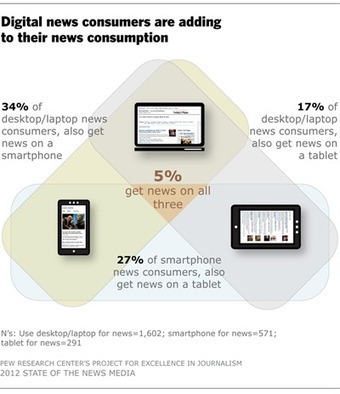


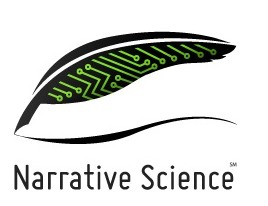

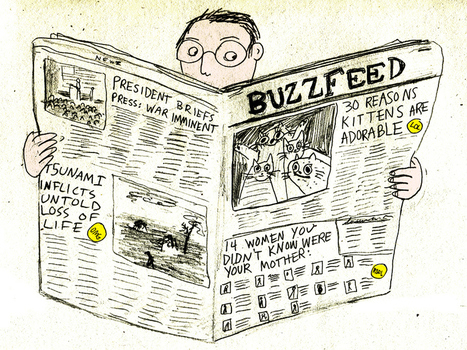









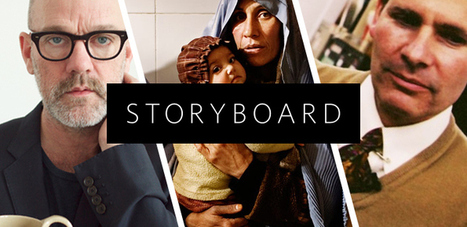



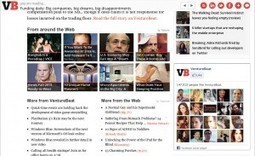





Instagram and Vine videos have provided a platform for users to view news instantly and share among their friends or through social media. Beth Bernett, assistant professor at the Medill School of Journalism, believes that video sharing on Instagram will become an essential tool for news organizations to share updates online. This in turn, will keep users engaged with live news updates, especially for those that don't watch the news frequently.